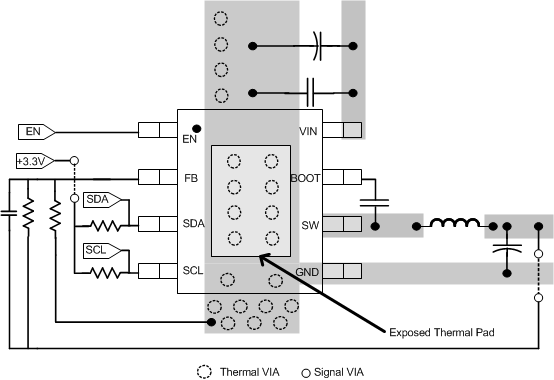SLVSCV3B March 2015 – June 2015 TPS566250
PRODUCTION DATA.
- 1 Features
- 2 Applications
- 3 Description
- 4 Simplified Schematic
- 5 Revision History
- 6 Pin Configuration and Functions
- 7 Specifications
- 8 Detailed Description
- 9 Applications and Implementation
- 10Power Supply Recommendations
- 11Layout
- 12Device and Documentation Support
- 13Mechanical, Packaging, and Orderable Information
Package Options
Mechanical Data (Package|Pins)
- DDA|8
Thermal pad, mechanical data (Package|Pins)
- DDA|8
Orderable Information
11 Layout
11.1 Layout Guidelines
- Keep the input switching current loop as small as possible.
- Keep the SW node as physically small and short as possible to minimize parasitic capacitance and inductance and to minimize radiated emissions. Kelvin connections should be brought from the output to the feedback terminal of the device.
- Keep analog and non-switching components away from switching components.
- Make a single point connection from the signal ground to power ground
- Keep the pattern lines for VIN and GND broad.
- Exposed pad of device must be connected to GND with solder.
- Output capacitor should be connected to a broad pattern of the GND.
- Voltage feedback loop should be as short as possible, and preferably with ground shield.
- Kelvin connections should be brought from the output to the feedback terminal of the device.
- Providing sufficient via is preferable for VIN, SW and GND connection.
- PCB pattern for VIN, SW, and GND should be as broad as possible.
- Input capacitors should be placed as near as possible to the device.
- If possible, it is preferred not to allow switching current to flow under the device
11.2 Layout Example
 Figure 37. Layout
Figure 37. Layout